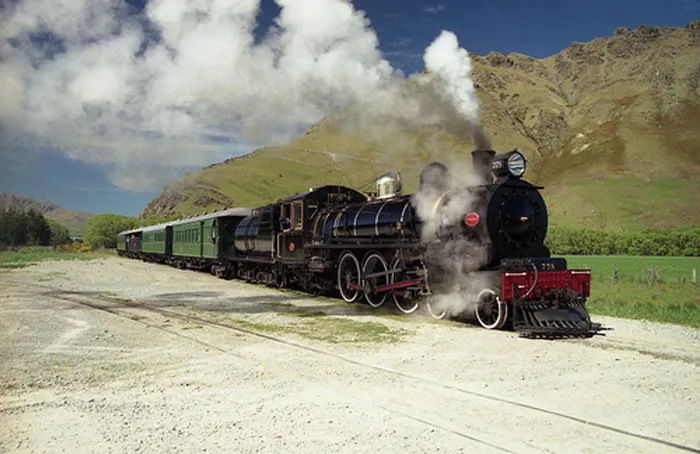Chugging into the past

Maybe the slightly sulphurous-smelling smoke is intoxicating, or perhaps for the older passengers the memories are extra-special - but those travelling on a steam train always seem to have broad smiles on their faces.
It was no different when we climbed aboard the Paton Country Narrow Gauge Railway (PCNGR) at Ixopo on Father's Day to do the 13km one-hour journey to Carrisbrooke.
While waiting for the engine to be coupled to the little wooden coaches - complete with padded wooden benches and the old South African Railways insignia of a springbok head on the small pull-up windows - there was time to get into the spirit of the outing with a cup of coffee and homemade rusks.
The two aluminium kettles whistling on the gas-ring transported one back to the waiting-rooms/restaurants of old where everyone fortified themselves for the journey ahead. It also sparked other memories.
"Remember how they used to bring coffee round first thing in the morning?" asked one passenger. "The steward always had a tall silver pot on a tray and you drank this wonderful coffee propped up in bed."
"Remember the dinner gong... someone went up and down the passages reminding you that dinner was ready," said another.
"Our mum always packed a hamper, so we were really envious of those who ate in the dining car," another reminisced.
Out on the track Julian Perreira, the driving force behind the PCNGR, was lovingly lubricating the wheels of one of the trusty old engines and making sure it was building up a fine head of steam.
There's an art to handling these vintage puffing Billys. If the driver doesn't get it right it pants to a halt on a rise, so Perreira uses experts to coach the best out of his beloved engines. One driver is affectionately known as "Oom Stoom" (Uncle Steam). It seems so fitting!
We puffed and hooted our way through various scenes: a large plantation had been cut down and the remaining stumps burned, opening vistas which would have otherwise been hidden; then through another plantation; past the tawny grasses of winter; and through a section of indig-enous forest, all damp and musty. This section was steep and the brakes squealed. Parts of the line are technically difficult - the steepest gradient a narrow gauge can handle.
At Carrisbrooke we climbed out and wandered up the hillside to look at the views made famous by Alan Paton in his book Cry the Beloved Country, while the engine was switched to the other end of the train ready for the return journey.
Such a trip would be incomplete without hearing a bit about the history of the line and Jocelyn (Julian's wife) gives a quick summary before each departure.
The first trip in 1999 sounded amazing. "We had a gangers' trolley with some pre-school kids on board, sitting back-to-back. It had to be pushed and when there were tree stumps in the way the trolley had to be lifted. On the downhill slopes the brake was firmly applied," said Jocelyn, mentioning that, because the track was overgrown in parts, the passengers had to dodge branches.
She described the silence when the kids stopped chattering excitedly, the flowers and birds.
She said that at good viewpoints the trolley stopped and Paton's son, Jonathan, read excerpts from his father's book. He did the same for Oprah Winfrey's crew some years later... but this time the journey was in a proper coach.
Jocelyn, head of the department in English at Ixopo High School until two years ago, mentioned how in the late 1990s the track was being ripped up and sold off as scrap metal to Britain and America. That was when Julian had an "epiphany" and decided to save some of the country's irreplaceable history.
He managed to stop the sale of the last bit of remaining track and sourced engines from different parts of the country.
"This is the oldest operational narrow gauge railway in the country and one of the garratts dates back to 1925, making it the oldest running garratt in the world and the second surviving one," said Jocelyn, explaining that a garratt is a locomotive with two sets of engine units, front and back, which is able to negotiate sharp curves.
This garratt was once in service at Weenen and when it was decommissioned stood on the platform there. A South African now living in the United States had his picture taken as a young boy in front of the garratt. "His name was also Garratt," said Jocelyn, mentioning that on a recent visit to South Africa, Garratt was devastated to find his namesake had been removed from Weenen. He traced it to Ixopo and rushed off to ride the line - which draws steam-train enthusiasts from around the world.
Many of the engines have a history. The seven-ton Lenning came from a salt mine at Koega; another from Mtwalume and another from Mid-Illovo where it tugged coaches laden with sugar cane. Even the station buildings have a history - having once been housed at Midmar dam or forming sheds at Richmond.
According to Julian, the PCNGR has created jobs for many locals in this depressed area. Workers dismantled tracks in other areas and re-laid them at Ixopo; helped with the restoration of coaches and buildings; and are now busy relaying the line down to Madonella, the terminus of this branch line.
A trip runs every Sunday on the narrow gauge line (sometimes a diesel is used when the fire-index is high).
There is also a standard gauge trip which follows the course of a river. It operates on special occasions (such as the Aloe Express in July). Another trip very popular with families sees canoes being loaded aboard. Everyone travels by train one way, then the canoeists paddle back, while passengers spur them on from the train running alongside.
Phone 082 374 1418 or 082 374 1417 for information.